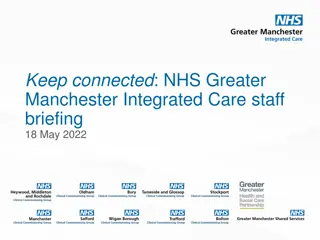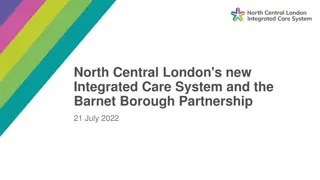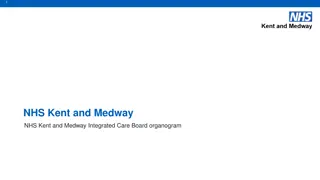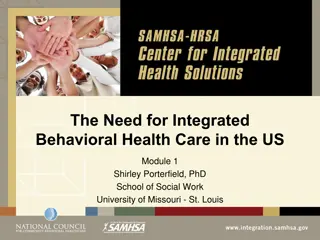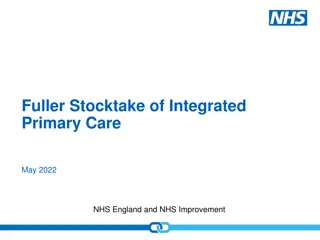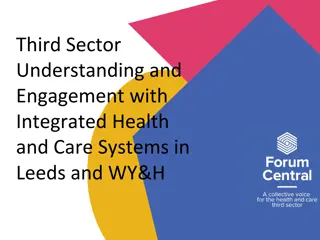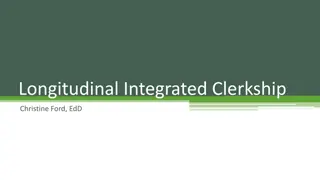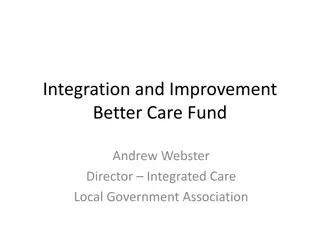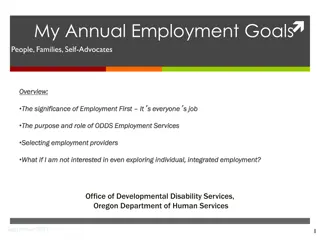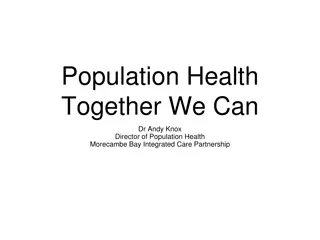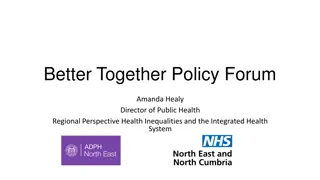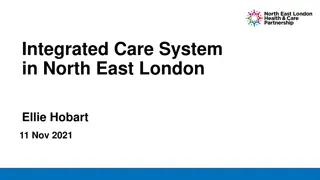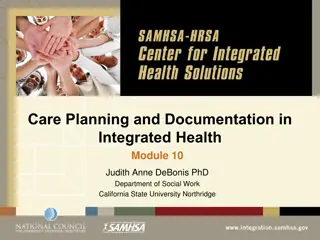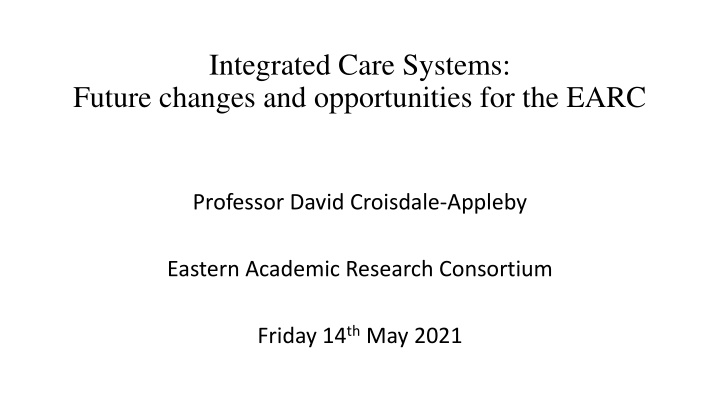
Future Changes in Integrated Care Systems: Opportunities for EARC
Explore the evolving landscape of Integrated Care Systems (ICSs) and the potential they hold for the Eastern Academic Research Consortium (EARC). Discover the current situation, challenges, future funding prospects, and research opportunities within the realm of ICSs. Delve into the structural underpinnings and transformative impact of ICSs on healthcare and social care integration.
Download Presentation

Please find below an Image/Link to download the presentation.
The content on the website is provided AS IS for your information and personal use only. It may not be sold, licensed, or shared on other websites without obtaining consent from the author. If you encounter any issues during the download, it is possible that the publisher has removed the file from their server.
You are allowed to download the files provided on this website for personal or commercial use, subject to the condition that they are used lawfully. All files are the property of their respective owners.
The content on the website is provided AS IS for your information and personal use only. It may not be sold, licensed, or shared on other websites without obtaining consent from the author.
E N D
Presentation Transcript
Integrated Care Systems: Future changes and opportunities for the EARC Professor David Croisdale-Appleby Eastern Academic Research Consortium Friday 14thMay 2021
Structure of this address 1. Integrated Care Systems current situation and direction of travel 2. Implications and challenges 3. Future research funding, and examples of research opportunities for EARC
Integrated care systems (ICSs) are recently established partnerships between the organisations to meet the health and care needs of its population across a specific, geographically delineated area, to coordinate services and to plan in a way that improves its population s health and reduces inequalities amongst different groups of its population. They bring together NHS, local authority and third sector bodies to take on responsibility for the resources and health of a geographic area or 'system'.
Currently, ICSs are organised via an alliance agreement amongst member organisations, and currently they are not underpinned by legal statute. ICSs are now agreed to be the future of place-based health and care integration in England. The NHS Long Term Plan and now the Government's white paper on health and care reform both place ICSs at the heart of the health and social care system. The ongoing development of ICSs presents both challenges and opportunities, they are not in themselves a panacea for better health and wellbeing outcomes, they are a place-based framework intended to facilitate such outcomes.
Health and social care are changing. NHS Five Year Forward View was published in October 2014 Followed by the NHS Long-Term Plan in February 2019 Creation of more than 1250 Primary Care Networks (PCNs) in England in July 2019 The recent white paper has been published in February 2021 The Health and Care Bill will focus on providing the necessary legal underpinning for the way in which health and social care is delivered
Importantly, it will overcome the problems created by the 2012 Care Act (the Lansley Reforms) which were based an underlying approach of competition, replacing it with an Act based on collaboration. The de facto merger of NHS England and NHS Improvement will be placed on a statutory footing and will be designated as NHS England (NHSE). NHSE will have the power to transfer functions between Arms Lengths bodies, and an improved level of accountability will be introduced within social care.
Why do things need to change? Primarily they need to change because our current health and care system is no longer capable of meeting the health and care needs of the population, because people are living longer, with more co-morbidities, and because our population is increasing.
Working together to integrate care It is intended that every part of the NHS, public health and social care should seek out ways to connect and collaborate so that the health and care needs of people are met, and to deliver improved outcomes to health and wellbeing for people in their locality. There will be two forms of this integration: (1) An ICS NHS body for integration within the NHS; and (2) An ICS Health and Care Partnership bringing integration through greater collaboration between the NHS and local government as well as other, wider delivery partners.
So what does this mean for General Practice? The vast majority of GP practices in England are already part of a Primary Care Network, PCN. Where the practice is not part of a PCN, the practice population will be included in PCN changes as part of the GP contract.
What does it mean for Clinical Commissioning Groups (CCGs)? The Government s white paper now proposes that rather than moving to a single CCG for each ICS it now intends to abolish CCGs altogether. ICSs would then take responsibility for the core functions currently carried out by CCGs, including: commissioning the design of care pathways patient outcomes population health financial governance.
The purpose of this extensive structural reformulation This population health approach will be informed by better data and understanding of local populations, identifying those who are at risk and upon whom we can have a highly positive impact, and designing a more proactive way of planning and delivering care. This requires the harnessing of the opportunities provided by data analytics and digitization. Social care providers can receive emergency financial support from the ICS. Moving the provision of care into the community and into people s own homes, and away from providing care in hospital settings.
Additional intervention powers from the government. The intended legislation will restore the power of the Secretary of State for Health and Social Care to intervene in the way in which NHSE operates, an intended power which is controversial. Responsibilities for public health. for example, NHSE will take on specific public health functions to help tackle obesity a new power for ministers to alter certain food labelling requirements streamlining the process for the fluoridation of water in England
Safety and quality improvement measures will be bought forward, eg: putting the Healthcare Safety Investigation Branch (HSIB) on a statutory footing enabling improvements to the regulatory landscape for healthcare professionals establishing a statutory medical examiner system within the NHS to scrutinise all deaths not involving a coroner allowing the MHRA to maintain publicly funded and operated medicine registries so that patients and their prescribers, as well as regulators and the NHS, have the evidence they need to make evidence-based decisions.
What does all this change actually mean for patients? For people using the NHS regularly, these proposals will support GPs and healthcare specialists to work together to arrange treatment and interventions that either prevent illness or prevent patients chronic conditions deteriorating into acute illness. Patient choice will remain an important aspect of patient care and more specialised services will be provided closer to home.
Integrated Care Systems and Adult Social Care ICS legislation will complement and reinvigorate place-based structures for integration between the NHS and Social Care. The ICS Health and Care Partnership will be a springboard to bring together health, local authorities, and other partners. Published guidance will show how ICS Health and Care Partnerships can be used to align operational practices and culture with the legislative framework, to ensure ICSs deliver for the adult social care sector. Legislative proposals for health and care reform for every part of England will begin to be implemented in 2022.
ICSs work at three key levels 1. System: work focussed on partners working together to set strategy, finance, workforce planning, and agree overall levels of integration. 2. Place: normally based around towns within the ICS, working at place level centres on the planning of localised services and secondary and community care. 3. Neighbourhood: based around Primary Care Networks (PCNs) groupings of GP practices covering populations of 30,000 to 50,000 people. Multi-disciplinary teams are central to PCNs, with clinicians and health and care professionals from a wide range of services working together.
Common themes in existing ICSs. Enhancing the scope of primary and community care Improving overall health by early and extended prevention measures Modelling future workforce requirements Better use of data, tech and innovation Service reconfiguration
Future research funding Research funding is likely to increase during the next five years. The focus is likely to be in fairly strict accordance with the direction of travel in the health and wellbeing sector. It will be particularly supportive of programmatic rather than single-event research, looking to both research and audit. There is an opportunity for a higher proportion of funded research to be place-specific as the social care component assumes a greater role. The 10 What Works Centres, of which the National Institute of Health and Care Excellence (NICE) was retrospectively nominated as the exemplar, are likely to be particularly favoured.
Some suggestions of areas of research The 3 universities are amongst the most innovative and agile universities in the UK in terms of research, and I will suggest just some of the areas in which their existing research reach can be extended in reflecting the needs of ICSs. So what follows are just some initial suggestions of areas of in which the 3 universities which comprise the EARC can benefit from the future direction of travel of Integrated health and social care, and the prominence of ICSs in that journey.
1. A truly in-depth knowledge in both quantitative and qualitative profile of the population you serve. 2. A multi-dimensional understanding of disadvantaged , marginalized and hard-to-reach communities, family units and individuals, who form the focus for targeted work in the key objectives set for ICSs. 3. Commissioning amongst an alliance of organisations where previously there was single-centre commissioning. 4. A great deal of the success of the ICS-based configuration is dependent on their ability to persuade different organisations to collaborate rather than compete for resources. 5. A key focus is the health and wellbeing of an ageing population, often with multiple comorbidities. 6. The UK Household Longitudinal Study offers the opportunity to monitor progress of health and wellbeing programmes through time.
7. Underlying the ICS approach is a recognition that our society is changing radically, requiring each ICS to understand in what ways and to what extent its society is changing, and the implications of this for the creation of better population health and wellbeing outcomes. 8. Establishing, and subsequently maintaining, an appropriate workforce in health and social care is perhaps the biggest challenge faced by most ICSs. 9. Much is said about the importance of patient choice, but if there are unreliable predictions of demand for physical health, mental health and care services, the resources will not be in place to provide choice. 10. Recognition of the role of voluntary sector organisations in contributing to the quality of services is something that should be greatly facilitated under the ICS structure, but this won t happen unless the impact of their contribution can be clearly demonstrated.
Questions and Comments are most welcome. Email: croisdaleappleby@gmail.com


